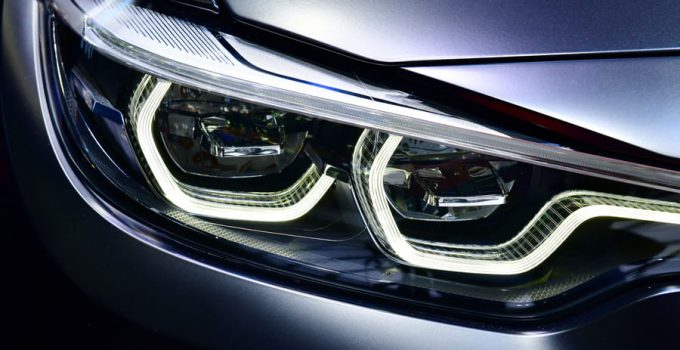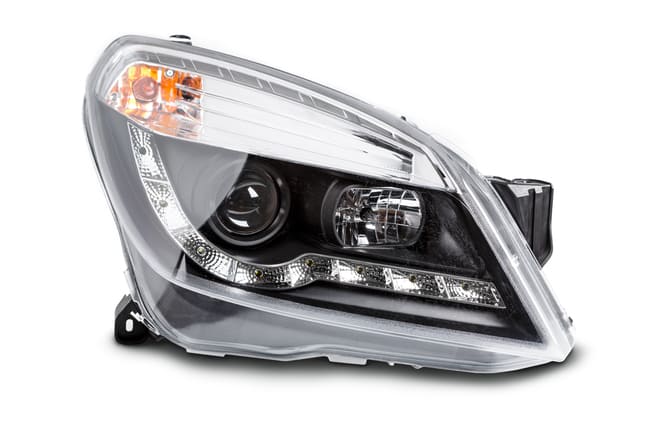
Properly working headlights are a must for road safety. In addition, the recommendation nowadays is increasingly to switch on the daytime running lights or low beam for better visibility on the road during the day. Since 2011, it has even been mandatory to install daytime running lights in new cars, which switch on automatically when the engine is switched on. In the meantime, in view of the increasing technology in the automotive sector, a large number of lights and headlight systems are installed on cars. In the following post we provide an overview of the types of lights and their functions.
Components and types of headlamps

Depending on the light source, the car light consists of different components. In addition to the housing, which includes all components and the lighting, there is the reflector. The reflector has the task of collecting the light emitted by the bulbs and directing it towards the road. Nowadays they are mainly made of plastic. With xenon headlights, projection modules are used instead of reflectors. These are equipped with a lens installed in front of the lamp, which is intended to direct the light beam. They are movable and can therefore come up with dynamic cornering lights.
The cover lenses serve to protect against water and to scatter and distribute the light. They are available as clear discs and as discs with a ribbed structure.
There are also adjustment screws on the headlights that can be used to align the headlights in the vertical and horizontal directions. Furthermore, there are different components to regulate the headlight range, which can be operated either electrically or pneumatically. In modern vehicles, instead of manual headlight range adjustment, there is an automated counterpart.
As far as the light source is concerned, there are three Types of lighting types:
- Halogen headlights: They are among the most common car lights and are popular because halogen lights can be replaced individually and even by non-professionals. The light generated by a halogen lamp has a light color of around 3,000 Kelvin. They come in different categories used for low and high beam: H1, H3, HB3, H4, H7, H9 and H11. Halogen lamps are equipped with diffusers so that the light does not dazzle. Halogen headlights often have manual adjustment, but nowadays they can also be retrofitted with automatic headlight range control.
- Xenon headlights: These appear many times brighter and wider than halogen headlights, but only need two thirds of electrical power.
The xenon lamp is a gas discharge lamp filled with xenon gas, in which an arc is ignited by means of a high-voltage pulse. This requires a high voltage of 20,000 volts, which is achieved using special ballasts. In addition, its light color of around 4,000 Kelvin is very reminiscent of daylight, which is intended to prevent signs of fatigue. With so-called bi-xenon headlights, the low beam and high beam are combined, with the high beam being covered by a screen when not in use. Automatic headlight range adjustment is mandatory for xenon or LED headlights, and a headlight cleaning system is required for luminosity in excess of 2,000 lumens.
- LED headlights: They are used more and more frequently. At their core, they consist of an LED chip made up of multiple layers of semiconductor connections through which current flows. This is how light is generated. Individually controllable LED chips are grouped according to a fixed pattern, enabling functions such as adaptive high beam, which can block out individual oncoming vehicles. With full-LED headlights, both low beam and high beam are generated by LEDs. LED headlights also rely on a light color similar to daylight, but come even closer to daylight at 5,500 Kelvin. Since the light is characterized by a targeted radiance and hardly any stray light, neither reflectors nor lenses are necessary. Their great advantage is that they are maintenance and wear-free, are considered to be extremely robust and durable and at the same time require up to 80 percent less energy. The disadvantage: If an LED is broken, the entire headlight module has to be replaced, which has an impact on the price.jpg” />
functions of car lights
On the car, there are different lights for different situations. Here is an overview:
- Daytime running lights (front): This light is used to make the car easier to see for other road users, even during the day. In modern vehicle models, it is switched on automatically when the engine is ignited. It uses far less energy than the low beams used at night, especially when they are made of LEDs. However, it is no longer allowed to be driven at dusk. They can easily be retrofitted.
- Low beam (front, rear): This light is one of the main headlights along with the parking light, fog light or high beam and is used to illuminate the road in the dark or when visibility is poor during the day. The latter is required by law (§ 17 StVO). It should be noted that the low beam is available in symmetrical and asymmetrical forms. Asymmetrical means that the light beam rises upwards on the right-hand side, which is due to the fact that traffic is on the right in this country. After all, oncoming vehicles on the left should not be dazzled, which is why the light-dark boundary runs lower on this side than on the right.
- Main beam (front): This light is used to see better and further, especially outside of town in the dark or when visibility is poor. It also acts as a headlight flasher. It can be recognized by its color from a blue indicator light in the cockpit.
- Parking light (front, rear): This position light is used for this purpose to make the parked vehicle visible to other road users outside of built-up areas in the dark, i.e. in unlit areas. It must not be used for driving, as this form of lighting is too weak.
- Fog lights (front) and rear fog lights (rear): This is intended to improve visibility in poor visibility conditions such as fog, snowfall or rain. It should be noted that the rear fog light may only be switched on in poor visibility of less than 50 m.jpg” />
- Indicators (left, right): Show the direction of travel.
- Brake Light (Rear): This light indicates that you are braking.
- Reverse Light (Rear): This light warns you indicates that you are driving backwards.
Newest Developments
There are now car models on the market that have modern automatic lighting or automatic assistance systems. Depending on the lighting and weather conditions, the low beam is automatically switched on, which is registered by special photodiodes and rain sensors, and switched off when the engine is switched off.
There are also cornering lights designed for cornering situations, which are activated either via the fog lights or in are integrated into the main headlights, as well as rotating main headlights that are adapted to the steering angle and also illuminate the lateral areas of the road when cornering.
Conclusion
With the increasing mechanization of the car, the lighting systems are also becoming more sophisticated and better adapted to the driver by simulating lighting conditions similar to daylight or illuminating curves. This contributes to relieving the burden on the driver and to road safety for everyone. But there are still car models that are equipped with older lighting systems and involve a greater amount of manual adjustment work. Nevertheless, the proper functioning of the car lighting and the driver's safety awareness are paramount. If necessary, some lights, such as the daytime running lights, can be retrofitted.
A tip from CarTipsandmore: When driving at night, do not look directly into the headlights of oncoming cars, but try to look at the lane or the one opposite look at the side of the road. In addition, free light checks are often offered in autumn, where you can have the headlight settings checked.
